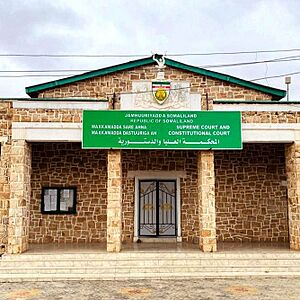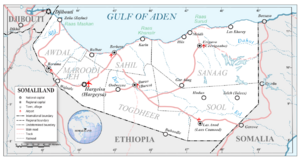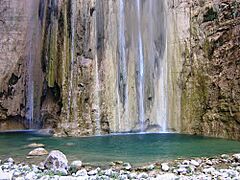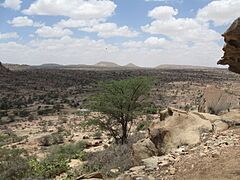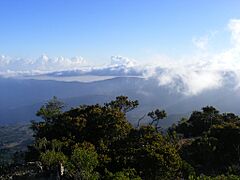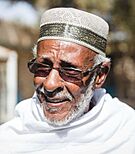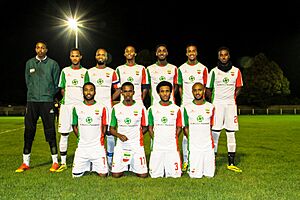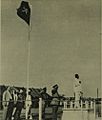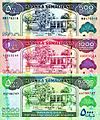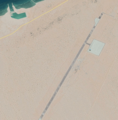Somaliland facts for kids
Quick facts for kids
Republic of Somaliland
|
|
|---|---|
|
|
|
|
Motto: لا إله إلا الله محمد رسول الله
Lā ilāhā illā-llāhu; muḥammadun rasūlu-llāh "There is no God but Allah; Muhammad is the Messenger of God" |
|
|
Anthem: Samo ku waar
حياة طويلة مع السلام "Live in Eternal Peace" |
|
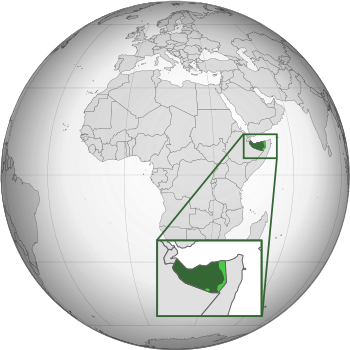
Territory controlled
Territory disputed |
|
| Capital and largest city
|
Hargeisa 9°33′N 44°03′E / 9.550°N 44.050°E |
| Official languages | Somali |
| Second language | Arabic, English |
| Religion | Islam (official) |
| Demonym(s) | |
| Government | Unitary presidential republic |
| Muse Bihi Abdi | |
| Abdirahman Saylici | |
|
• Speaker of the House
|
Yasin Haji Mohamoud |
| Legislature | Parliament |
| House of Elders | |
| House of Representatives | |
| Unrecognised independence
from Somalia
|
|
|
• Isaaq Sultanate
|
1750–1884 |
|
• Establishment of British protectorate
|
1884 |
|
• Independence of the State of Somaliland
|
26 June 1960 |
|
• Union with the Trust Territory of Somaliland
|
1 July 1960 |
| 18 May 1991 | |
|
• Current constitution
|
13 June 2001 |
| Area | |
|
• Total
|
76,000 km2 (29,000 sq mi) |
| Population | |
|
• 2024 estimate
|
6,200,000 (109th) |
|
• Density
|
28.27/km2 (73.2/sq mi) |
| GDP (nominal) | 2022 estimate |
|
• Total
|
$3.782 billion |
|
• Per capita
|
$852 |
| Currency | Somaliland shilling |
| Time zone | UTC+3 (EAT) |
| Date format | d/m/yy (AD) |
| Driving side | right |
| Calling code | +252 (Somalia) |
Somaliland, officially known as the Republic of Somaliland, is a region in the Horn of Africa. It acts like an independent country but is not officially recognized by most other countries or the United Nations. Somaliland is located on the southern coast of the Gulf of Aden. It shares borders with Djibouti to the northwest, Ethiopia to the south and west, and Somalia to the east.
The area Somaliland claims is about 176,120 square kilometers (68,000 square miles). As of 2024, about 6.2 million people live there. The capital and largest city is Hargeisa.
Contents
History of Somaliland
Various Somali Muslim kingdoms existed in this area long ago. One important kingdom was the Adal Sultanate, which was based in Zeila during the 14th and 15th centuries. Later, in the mid-1700s, the Isaaq Sultanate was formed.
Becoming a British Protectorate
In the late 1800s, the United Kingdom made agreements with local clans. This led to the creation of the Somaliland Protectorate. This area gained its independence from the United Kingdom on June 26, 1960, becoming the State of Somaliland.
Joining and Leaving Somalia
Just five days after its independence, on July 1, 1960, the State of Somaliland chose to unite with the Trust Territory of Somaliland (which was formerly Italian Somalia). Together, they formed the Somali Republic.
However, this union faced problems early on. The government of Somalia treated the main clan in Somaliland, the Isaaq, very harshly. After a difficult war called the Ogaden War, a 10-year war for independence began. This war ended in 1991 when Somaliland declared itself independent again. The current Government of Somaliland sees itself as the direct successor to the old British Somaliland.
Seeking International Recognition
Since 1991, Somaliland has been run by governments chosen through democratic elections. These governments are working to get other countries to officially recognize them as the Republic of Somaliland.
Somaliland has informal connections with some foreign governments. These governments have sent groups to visit Hargeisa. Somaliland also has offices from several countries, including Ethiopia and Taiwan. However, no country that is a member of the United Nations, or any major international organization, has officially recognized Somaliland's independence. It is the largest region in the world that acts like a country but is not officially recognized. Somaliland is a member of the Unrepresented Nations and Peoples Organization, which helps groups that are not recognized or are occupied.
Government of Somaliland
The Constitution of Somaliland explains how the government works. Somaliland is a single country with a president as its leader. Its government is based on peace, cooperation, democracy, and having many political parties.
The President and Executive Branch
The country's leader is the President, who is elected by the people. The President's government includes a Vice President and a group of ministers called the Council of Ministers. These ministers are in charge of the daily running of the government. The President chooses them, and the Parliament's House of Representatives must approve them. Any new laws passed by Parliament need the President's approval before they become official. The National Electoral Commission confirms presidential elections. A president can serve a maximum of two five-year terms.
The Parliament and Legislative Branch
The power to make laws belongs to the Parliament. It has two parts: the House of Elders (the upper house) and the House of Representatives (the lower house). Each house has 82 members.
Members of the House of Elders are chosen by local communities for six-year terms. This house helps pass laws with the House of Representatives. It also helps solve disagreements within the country. The House of Elders has the special power to extend the terms of the President and representatives if an election cannot happen.
Members of the House of Representatives are directly elected by the people for five-year terms. This house also votes on laws with the House of Elders. However, if the House of Elders rejects a law, the House of Representatives can still pass it with a two-thirds majority vote. This house has complete control over money matters and must approve most of the President's choices for government positions.
The Judicial System
The court system is made up of several levels: district courts, regional courts, regional appeals courts, and the Supreme court. The Supreme Court is the highest court in the land and also acts as the Constitutional Court.
Somaliland nationality law explains who is a citizen of Somaliland. It also describes how someone can become a citizen or give up their citizenship. The Somaliland government still uses the 1962 laws from the Somali Republic for its criminal code.
Administrative Divisions
Somaliland is divided into six main administrative regions: Awdal, Sahil, Maroodi Jeeh, Togdheer, Sanaag and Sool. These regions are further divided into eighteen smaller administrative districts.
Geography and Climate
Somaliland is located in the northwest part of what is recognized as Somalia. It is found between 8°N and 11°30'N latitude, and 42°30'E and 49°00'E longitude. It shares borders with Djibouti to the west, Ethiopia to the south, and Somalia to the east. Somaliland has a long coastline of about 850 kilometers (528 miles) along the Gulf of Aden. The total land area is about 176,120 square kilometers (68,000 square miles).
Somaliland's Landscape
Somaliland has a mix of wet and dry areas. The northern part of the region is hilly, with many places reaching between 900 and 2,100 meters (2,950 and 6,890 feet) above sea level. The Awdal, Sahil, and Maroodi Jeex regions have fertile land and mountains. Togdheer is mostly a semi-desert with only a little green vegetation. The Awdal region is also known for its islands, coral reefs, and mangrove forests.
A dry, scrub-covered plain called the Guban runs along the coast of the Gulf of Aden. This plain is usually dry, except during the rainy seasons when its small bushes and grass become lush and green.
The Cal Madow is a mountain range in the eastern part of the country. It includes Shimbiris, Somaliland's highest peak, which is about 2,416 meters (7,927 feet) high. Further inland, the northern mountains turn into flat plateaus and dry riverbeds, locally known as the Ogo. The western part of the Ogo gradually blends into the Haud, which is an important area for grazing livestock.
- Landscapes of Somaliland
Somaliland's Climate and Seasons
Somaliland is located just north of the Equator and has a semi-arid climate. Average daily temperatures range from 25°C to 35°C (77°F to 95°F). The sun is directly overhead twice a year, on March 22 and September 23.
Somaliland has three main climate zones:
- Coastal Plain (Guban): This zone has high temperatures and low rainfall. Summer temperatures often go above 38°C (100°F). In winter, temperatures drop, and more people and animals move to this region.
- Coastal Range (Ogo): This is a high plateau south of Guban, with elevations from 1,800 meters (6,000 feet) in the west to 2,100 meters (7,000 feet) in the east. It receives more rain than Guban.
- Plateau (Hawd): This region is south of the Ogo range. It is usually more populated during the wet season when there is surface water. It is also an important area for animals to graze.
Somalilanders recognize four seasons:
- Gu: The main rainy season (late March to early June). This is when the Ogo range and Hawd get the most rain. It's a time of fresh grass and plenty of water, and animals breed during this period.
- Hagaa: From late June through August, this season is usually dry, though the Ogo range sometimes gets scattered showers called Karan rains. Hagaa is generally hot and windy.
- Deyr: The second, smaller rainy season (September to early November). It usually has less rain than Gu.
- Jiilaal: Winter (late November to early March). This is the coolest and driest time of the year. The Hawd gets almost no rain in winter. The Guban zone gets rain, called "Hays," from December to February.
The humidity in Somaliland ranges from 63% in the dry season to 82% in the wet season.
People and Culture
Languages Spoken in Somaliland
Most people in Somaliland speak Somali and Arabic. The Constitution of 2001 states that Somali is the official language. Arabic is a required subject in schools. English is also commonly spoken and taught in schools. The main Somali dialect spoken is Standard Somali, which is used by most media in the region.
Religion in Somaliland
Almost all Somalilanders are Muslims. Islam is the official state religion, and practicing other religions is against the law. While there are small amounts of non-Islamic traditions, Islam is very important to the Somali people's sense of national identity. Most Somalis do not belong to a specific mosque or religious group and can pray in any mosque they choose.
Economy of Somaliland
The economy of Somaliland relies heavily on livestock. Sheep, camels, and cattle are shipped from the port of Berbera to countries in the Persian Gulf, like Saudi Arabia.
Agriculture is seen as an industry with good potential, especially for growing grains and garden crops. Mining also has potential, but currently, only simple quarrying (taking stone from the ground) is done, even though there are many different types of minerals.
Culture of Somaliland
Food and Meals

It is considered polite to leave a small amount of food on your plate when you finish a meal at someone's home. This shows the host that you have been given enough food. If you clean your plate completely, it might suggest you are still hungry. However, most Somalis do not take this rule too seriously.
A typical Somali breakfast includes a flatbread called lahoh (similar to injera), along with liver, toast, cereal, and porridge made from millet or cornmeal. Lunch often consists of rice or pasta with meat and sauce. A traditional soup called maraq, similar to Yemeni cuisine, is also eaten at lunchtime. Maraq is made with vegetables, meat, and beans, and is usually eaten with flatbread. Later in the day, a lighter meal is served, which might include beans, ful medames, muffo (patties made of oats or corn), or a salad with more lahoh.
Arts and Poetry
Islam and poetry are very important parts of Somali culture. Somali poetry is mostly spoken, with both male and female poets. They use common Somali words and ideas as metaphors in their poems.
Almost all Somalis are Sunni Muslims, and Islam is vital to their national identity. Most Somalis do not belong to a specific mosque or religious group and can pray in any mosque they find.
Celebrations in Somaliland are often religious festivals. Two of the most important are Eid ul-Adha and Eid ul-Fitr, which marks the end of the fasting month of Ramadan. Families dress up to visit each other, and money is given to those in need. Other holidays include June 26, which celebrates British Somaliland's independence, and May 18, which celebrates the establishment of the Somaliland region. However, May 18 is not recognized by the international community.

In the traditional nomadic culture, where people often move their belongings, there isn't much focus on creating detailed visual art. However, Somalis do decorate their woven and wooden milk jugs (haamo). Traditional dance is also important, especially as a way for young people to meet. One popular dance is called Ciyaar Soomaali.
Henna art is an important part of Somali culture. The tradition of applying henna goes back a very long time. For special events, Somali women's hands and feet are decorated with beautiful henna designs. Girls and women usually apply henna for celebrations like Eid or weddings. The designs can be very simple or very detailed. Somali designs can be modern and simple, or traditional and complex. Traditionally, only women use henna as body art, as it is seen as a feminine custom. Henna is also used as a dye. Both Somali men and women use henna to color their hair. Women often apply henna to their hair because they usually wear a hijab.
Sports in Somaliland
Popular sports in Somaliland include football, track and field, and basketball. Somaliland has a national football team, but it is not a member of FIFA (the international football organization) or the Confederation of African Football.
Images for kids
-
Map of Somaliland in the 19th century.
-
Wild animals shown in the caves of Dhaymoole, many of which are now extinct in the region.
-
The Italian newspaper Corriere della Sera covering the start of the British Somaliland offensive. -
The White and Blue Somali Flag at the Independence celebrations on June 26, 1960. The prime minister of the State of Somaliland and the second president of Somaliland, Muhammad Haji Ibrahim Egal, salute the flag.
-
Livestock export in Berbera, Somaliland.
-
Traditional Somali Qur'anic tablet.
-
Berbera beach.
See also
 In Spanish: Somalilandia para niños
In Spanish: Somalilandia para niños





